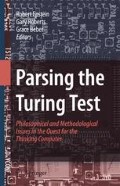Abstract
The present article describes a possible method for the automatic discovery of a universal human semantic-affective hyperspatial approximation of the human subcognitive substrate – the associative network which French (1990) asserts is the ultimate foundation of the human ability to pass the Turing Test – that does not require a machine to have direct human experience or a physical human body. This method involves automatic programming – such as Koza’s genetic programming (1992) – guided in the discovery of the proposed universal hypergeometry by feedback from a Minimum Intelligent Signal Test or MIST (McKinstry, 1997) constructed from a very large number of human validated probabilistic propositions collected from a large population of Internet users. It will be argued that though a lifetime of human experience is required to pass a rigorous Turing Test, a probabilistic propositional approximation of this experience can be constructed via public participation on the Internet, and then used as a fitness function to direct the artificial evolution of a universal hypergeometry capable of classifying arbitrary propositions. A model of this hypergeometry will be presented; it predicts Miller’s “Magical Number Seven” (1956) as the size of human short-term memory from fundamental hypergeometric properties. A system that can lead to the generation of novel propositions or “artificial thoughts” will also be described.
Access this chapter
Tax calculation will be finalised at checkout
Purchases are for personal use only
Preview
Unable to display preview. Download preview PDF.
References
Bengio, Y., Ducharme, R., and Vincent, P., 2000, A neural probabilistic language model, NIPS, pp. 932–938.
Bullinaria, J. A., 1995, Modeling lexical decision: who needs a lexicon? in: J.G. Keating, Neural Computing Research and Applications III, St. Patrick’s College, Maynooth, Ireland, pp. 62–69.
Dawkins, R., 1986, The Blind Watchmaker, Penguin, London.
Fleischmann, R. D., Adams, M. D., White, O., Clayton, R. A., Kirkness, E. F., Kerlavage, A. R., Bult, C. J., Tomb, J.-F., Dougherty, B. A., Merrick, J. M., McKenney, K., Sutton, G., FitzHugh, W., Fields, C., Gocayne, J. D., Scott, J., Shirley, R., Liu, L.-I., Glodek, A., Kelley, J. M., Weidman, J. F., Phillips, C. A., Spriggs, T., Hedblom, E., Cotton, M. D., Utterback, T. R., Hanna, M. C., Nguyen, D. T., Saudek, D. M., Brandon, R. C., Fine, L. D., Fritchman, J. L., Fuhrmann, J. L., Geoghagen, N. S. M., Gnehm, C. L., McDonald, L. A., Small, K. V., Fraser, C. M., Smith, H. O., and Venter, J. C., 1995, Whole-genome random sequencing and assembly of Haemophilus influenzae Rd. Science269: 496–512
French, R. M., 1990, Subcognition and the limits of the Turing Test, Mind99(393): 53–65.
French, R. M., 2000, Peeking behind the screen: the unsuspected power of the standard Turing Test, Journal of Experimental and Theoretical Artificial Intelligence12: 331–340.
Koza, J. R., 1992, Genetic Programming: On Programming of Computers by Natural Selection, MIT Press, Cambridge, MA.
Koza, J. R., 1999, Human-competitive Machine Intelligence by Means of Genetic Algorithms, Festschrift in honor of John H. Holland.
Lazarus, R. S., 1991, Emotion and Adaptation, Oxford University Press, New York, pp. 63–64.
Le Lionnais, F., 1983, Les Nombres Remarquables, Hermann, Paris, p. 58.
Lenat, D., Prakash, M., and Shepherd, M., Winter, 1986, CYC: using common sense knowledge to overcome brittleness and knowledge acquistion bottlenecks, AI Magazine6(4): 65–85.
Lund, K., Burgess, C., and Atchley, R. A., 1995, Semantic and associative priming in highdimensional semantic space, Proceedings of the Cognitive Science Society, pp. 660–665.
MacKay, D. M., 1951, In search of basic symbols, Cybernetics(Eighth Conference, 1951) 8: 222.
McKinstry, K. C., 1997, Minimum intelligent signal test: an objective Turing Test, CanadianArtificial IntelligenceSpring/Summer, pp. 17–18.
Mehrabian, A., 1980, Basic Dimensions for a General Psychological Theory, Oelgeschlager, Gunn, & Hain, Cambridge, MA.
Meyer, D. E. and Schvaneveldt R. W., 1971, Facilitation in recognizing pairs of words: evidence of a dependence between retrieval operations, Journal of Experimental Psychology90: 227–234.
Miller, G. A., 1956, The magical number seven, plus or minus two: some limits on our capacity for processing information, The Psychological Review63: 81–97.
Morgan, R. and Heise, D. R., 1988, Structure of emotions, Social Psychology Quarterly51: 19–31.
Roberts, L., 2001, Controversial from the start, Science291(5507): 1182–1188.
Shaver, P., Schwartz, J., Kirson, D., and O’Connor, C., 1987, Emotion knowledge: further exploration of a prototype approach, Journal of Personality and Social Psychology52: 1061–86.
Shannon, C. E., 1948, A mathematical theory of communication, Bell System Technical Journal27(July and October): 379–423 and 623–656.
Thomson, W., 1891, Electrical units of measurement Constitution of Matter (Nature Series Popular Lectures and Addresses vol 1) (London: Macmillan) pp. 80–134.
Turing, A. M., 1950, Computing machinery and intelligence, Mind59(236): 433–560.
Wells, D., 1986, The Penguin Dictionary of Curious and Interesting Numbers, Penguin Books, Middlesex, England.
Wundt, W. M., 1897, Outlines of Psychology, Translated by C. H. Judd, Wilhelm Engelmann, Leipzig, Germany, 180.
Author information
Authors and Affiliations
Editor information
Editors and Affiliations
Rights and permissions
Copyright information
© 2009 Springer Science+Business Media B.V.
About this chapter
Cite this chapter
Mckinstry, C. (2009). Mind as Space. In: Epstein, R., Roberts, G., Beber, G. (eds) Parsing the Turing Test. Springer, Dordrecht. https://doi.org/10.1007/978-1-4020-6710-5_17
Download citation
DOI: https://doi.org/10.1007/978-1-4020-6710-5_17
Published:
Publisher Name: Springer, Dordrecht
Print ISBN: 978-1-4020-9624-2
Online ISBN: 978-1-4020-6710-5
eBook Packages: Computer ScienceComputer Science (R0)

